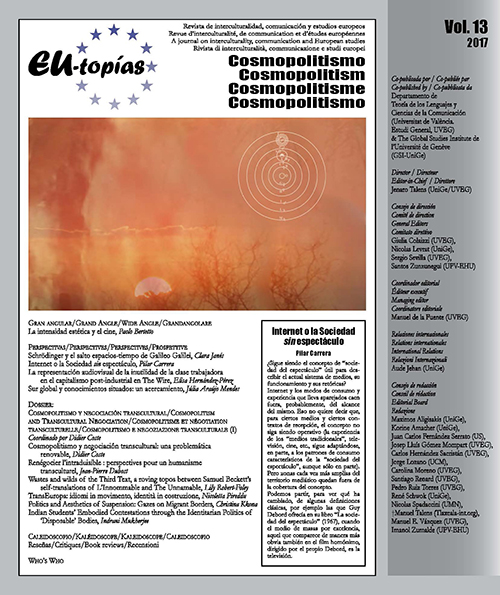Schrödinger and Galileo Galilei’s spaces-time jump
DOI:
https://doi.org/10.7203/eutopias.0.18613Keywords:
Universe, earth, movement, peripatetic, atom, electric charge Abstract
Abstract
In 1955 Erwin Schrödinger published in the magazine of a school in Dublin the Fragment of an unpublished dialogue of Galileo. In it he placed the latter at the beginning of the twentieth century and, as opposed to what he himself proposed to demonstrate in his Dialogue on the two highest systems of the world, presents him as interested on what has the smallest dimensions,that is, the atom and the subatomic particles. Opposing certain ideas ofAristotle, the purpose of Galileo was to open the door to heliocentrism and the movements of the earth and of the whole cosmos, following the theory of Copernicus. In his work, the defense of these two issues are discussed, confronting a third peripatetic philosopher, which gives rise to situations full of humor. Schrödinger resorts to the same characters of the Pisan, and in the same style, which coincides with his own, and also uses surprise, so that the reader has to guess what heroes and theories he refers to.
 Downloads
Downloads
 References
References
Navarro Brotons, Víctor, ed. (1991). Galileo. Barcelona: Ediciones Península: 121-219.
Galilei, Galileo (2017). La gaceta sideral & Johannes Kepler, Conversación con el mensajero sideral. Madrid: Alianza Editorial.
Schrödinger, E (2014). Candentes Cenizas, seguido de Fragmento de un diálogo inédito de Galileo. Trad. de Clara Janés. Madrid: Salto de Página.
Schrödinger, E. (1987) Mente y materia, Tusquets Editores, Barcelona, 1990.
Spinoza, Ética, Alianza Editorial, 1987.
Downloads
Published
How to Cite
-
Abstract219
-
PDF (Español)59
Issue
Section
License
![]()
The authors conserve the copyright. All content published in EU-topías. Journal of interculturality, Communication, and European Studies are subject to the license Creative Commons Attribution-NonCommercial-ShareAlike 4.0 license. The full text of the license can be found at <http://creativecommons.org/licenses/by-nc-sa/4.0>
They may be copied, used, disseminated, transmitted and publicly displayed, provided that:
- The authorship and original source of the publication is cited (journal, publisher and URL of the work).
- They are not used for commercial purposes.
- The existence and specifications of this license of use are mentioned.
It is the responsibility of the authors to obtain the necessary permissions for images that are subject to copyright.



